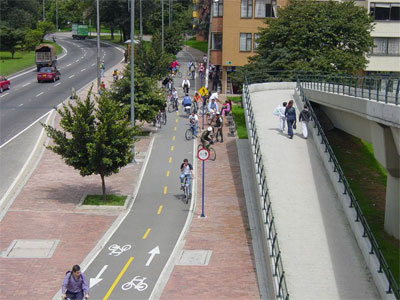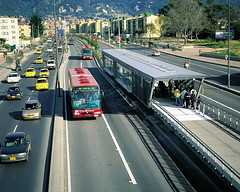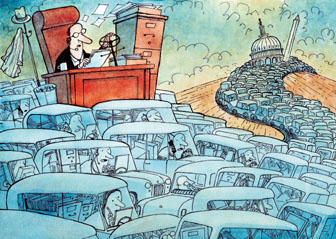Peddling car-free, bike-friendly days for Baltimore
 Bike path, Bogota, Colombia. Photo from the Institute for Transportation and Development Policy.
Bike path, Bogota, Colombia. Photo from the Institute for Transportation and Development Policy.The Baltimore Sun ran an article yesterday, "Peddling car-free, bike-friendly days for Baltimore," that has a big discussion of Enrique Peñalosa's tenure as Mayor of Bogota, and all the pro-public space and transportation initiatives he pushed forward during his term. (Mayors cannot serve consecutive terms in Bogota.) Thanks to Paul Johnson for alerting me to this article.
From the article:
Every Sunday, a 19th-century silence descends upon that mountain city. Some 75 miles of connecting streets are closed to traffic from 7 a.m. to 2 p.m. As many as 2 million people pour forth to walk, cycle, Rollerblade, jog and simply socialize in communal peace. No cars. No pollution. No gridlock. No roar of traffic.
"Ciclovia," as it's known, is the world's biggest block party, an urban transformation that borders on magical. "It's like everyone puts on a new suit of clothes," says Cantori. A thought quickly ballooned in his brain: Why not export the idea to Maryland?
Ciclovia actually started 20 years ago, but with only four miles of roads closed to traffic. The event was vastly expanded under Peñalosa's tenure. More from the article:
His "politics of happiness" is rooted in a kind of populist ecology. In Peñalosa's opinion, cities need to better reflect the common good. Therefore, he set about building a world-class bus system, the TransMilenio. During his tenure as mayor, 100,000 trees were planted and some 200 miles of bike paths opened.
 Photo by Peter Danielsson from "Bogotá designs transportation for people, not cars," from the World Resources Institute website. (Click through for the full-size photo, which is quite amazing.) Judging by the photo, Transmilenio appears to be modeled after the bus rapid transit system in Curitiba, Brazil, initiated by another member of the small fraternity of the world's greatest mayors, Jaime Lerner.
Photo by Peter Danielsson from "Bogotá designs transportation for people, not cars," from the World Resources Institute website. (Click through for the full-size photo, which is quite amazing.) Judging by the photo, Transmilenio appears to be modeled after the bus rapid transit system in Curitiba, Brazil, initiated by another member of the small fraternity of the world's greatest mayors, Jaime Lerner.In addition, the first Thursday of February became a car-free day in Bogota. A system of odd-even license plate restrictions also was adopted during rush hours, reducing traffic 40 percent.
"The most important thing is the equity aspect of it," explains Oscar Edmundo Diaz, a former aide to Peñalosa who is now Latin American regional director of the Institute for Transportation and Development Policy. "The beauty of the Ciclovia is, it's a place where everyone meets as equals. You are basically connecting poor neighborhoods with rich neighborhoods."
Bogota has continued on the environmentally progressive course he and Peñalosa set. Indeed, the long-range goal - currently the subject of legal wrangling - is to ban virtually all cars within city limits during morning and evening peak hours by 2015.
No American city (or mayor) is ready to take that radical a quality-of-life step, but officials in Boston, Cleveland and Philadelphia reportedly are contemplating Ciclovia-inspired weekend road closures. Chicago, however, may be ready to roll this fall. Mayor Richard M. Daley has signed off on a "Sunday Parkways" program that would block off three to eight miles of city streets from noon to 5 p.m.
Interestingly enough, a lot of the things that Peñalosa says are echoed by Mayor Joseph Riley of Charleston, South Carolina, however, Mayor Riley tends to focus more on the quality of the built environment, rather than transportation and mobility, and so public space advocates tend to be less familiar with him, unless they are staunch preservationists. Mayor Riley's "stock" speech is clickable here.
The idea of designing transportation systems for people rather than cars is particular relevant in DC these days, as various interest groups are up in arms over parking for churches on Sundays, calls (which I term insane) for government-constructed parking structures in residential neighborhoods, and complaints by the normally insightful NARPAC, which after all, is a band of suburbanites interested in DC issues (but hey I write here telling the suburbs what to do, so I guess it works both ways), that the latest DC Department of Transportation master plan doesn't call for expanding roads (and presumably freeways) as well as under-feeds the subway system in favor of streetcars and other mobility options.
See the current issue of themail for more about this, and specifically these entries:
-- "Cars Are the Problem" (by me, so you know it's relevant...);
-- "Churches, Parking and Great Cities" by Cheryl Cort, with more inspiring language than my entry, which focused on the technical; and
-- "Stunting Growth by Thinking Small" by Len Sullivan of NARPAC--calling DDOT "DC’s Department of Cyclists and Trolleys" shows his commuter and pro-car bias, although once I bristled at his commentary on the "K Street Busway" which among other comments included this one--"Pedestrians are a hindrance." (I think he is probably reacting to the DC portion of this document "The FY 2006-2011 Transportation Improvement Program (TIP)" from the Metropolitan Washington Council of Governments.
With regard to thinking small, I think a simple "solution" to his concern about truck transportation can be summed up in two words = "time shifting." E.g., during the week, it can take an hour or more to drive from Wisconsin and M Streets NW to Bethesda's Metro Center. Except for Thursday-Saturday nights, in the late evening, you can make this drive in 12-15 minutes...
 Drive time, image by David Clark (via The Washington Times).
Drive time, image by David Clark (via The Washington Times). Index Keywords: urban-design-placemaking



0 Comments:
Post a Comment
<< Home